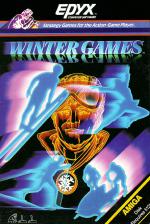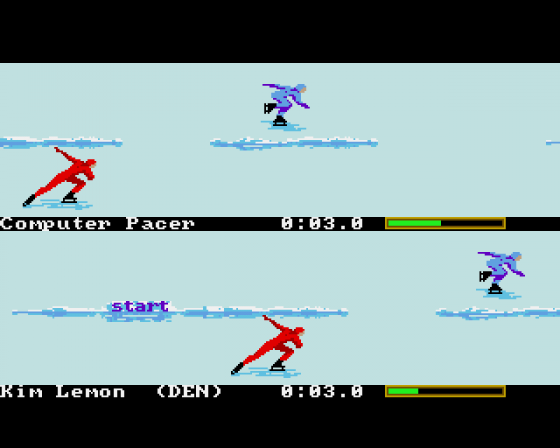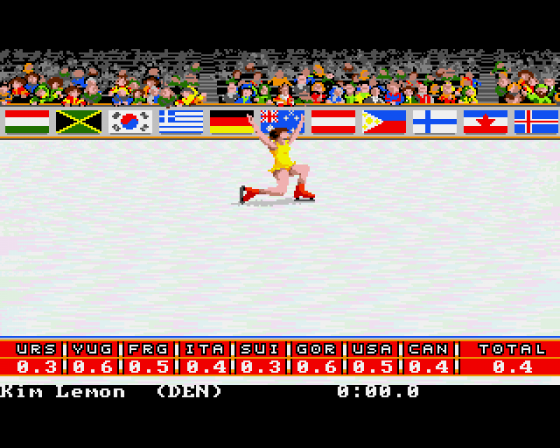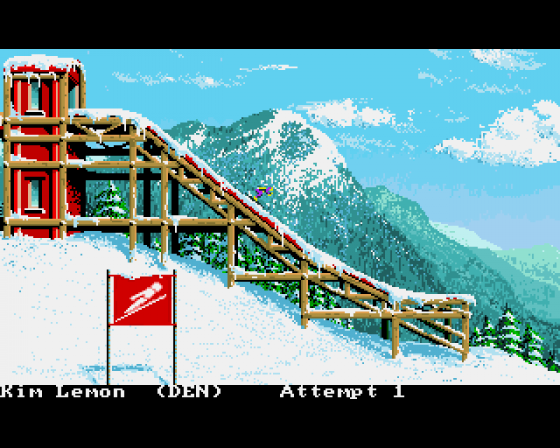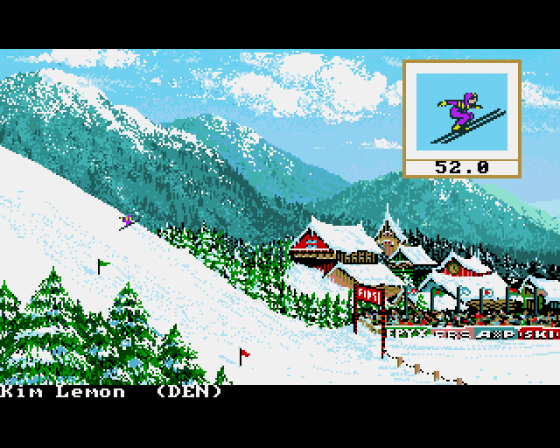
Commodore User
 1st September 1987
1st September 1987
Categories: Review: Software
Author: Francis Jago
Publisher: Epyx
Machine: Amiga 500
Published in Commodore User #48
Winter Games
Just before I start this review, I must tell you a joke which I heard last week: "What are an Englishman's two favourite days of the year? Christmas day and Summer!! Geddit?! The reason for this humorous break from the usual hard-hitting Commodore User Amiga games reviews is that the game I have been testing is about as relevant in the middle of our supposed summer as taking thermal underwear to Greece.
Regular readers of this magazine will already know that I am a dedicated fan of this type of game and rate World Games up with almost anything else I have played. It will not surprise you, therefore, to learn that Winter Games too is a cracker. Many of the features are carried over, including the loading and theme music.
Winter Games (or WG as I will now call it, purely to save my poor fingers from getting cramp) is split into seven separate events, each one of which plays completely independently. Once the opening ceremony has taken place, you are faced with the choice of competing in all the events, competing in some, viewing the world records, or simply practising.

Having played this type of game before, and generally being a pretty self-confident guy I jumped in and took on all events. After entering my name and choosing a country to represent, I was confronted with an event that had me instantly baffled; figure skating. After five minutes' reading of the manual (which, incidentally, is both clearly written and informative), I got the gist of what had to be done, and began. One minute later, after the worst skating routine imaginable, and a score of 0.2, I was back at the manual searching for clues! It turns out that it is not good enough just to skate forwards and backwards, but that you must perform a certain number of tricks, and all within a specified time.
God must have taken my vow literally, for it turns out that the next event is free skating. Using the same impressive graphics as figure skating, with a huge and excellently animated female character moving effortlessly (unless I am in control) across a shimmering rink of ice, free skating plays identically, except that there are no set routines. Aha, I thought, a chance for me to improve. Obviously the judges were not impressed, and I managed the fabulous total 1.2!
You can imagine my dismay, therefore, when I saw that the next event was speed skating. Not more skating!!! In fact, turns out that speed skating is a much simpler task, that relies less on dexterity, and more on rhythm and timing. The concept is simple enough; you must race the computer over a 300 metre course as fast as possible, although in practice the only real challenge is improving on your own times. Again the graphics are good, if not quite up to the high standard of the rest of the game.
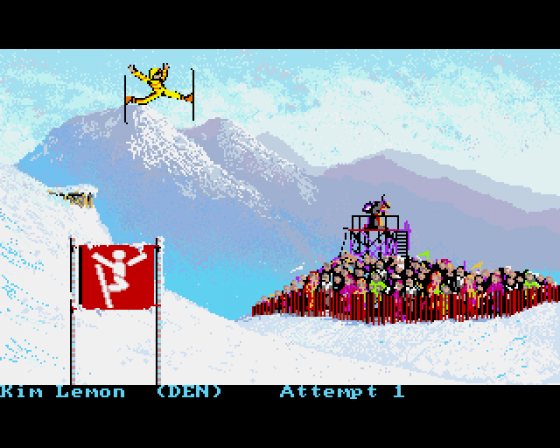
It was on the next event that I knew I would get hooked; hot dogging. As a sport I am unlikely ever to try, especially as the thought alone makes me feel uncomfortably queasy, this is one of the best of play on a computer. The object is to jump off a small ramp and perform as many varied stunts as possible before you land smoothly on the ground. There are a total of six different stunts, all of which receive different scores, by combining two it is even possible to score a perfect 10.
Of the stunts, the most dynamic are back flips and mule kicks, both of which look completely impossible. As with all of the best games (or in this case events) when hot dogging you find yourself gripping the joystick like a vice, and only when you have landed safely do you realise quite how much effort you have put into this supposedly relaxing pastime.
Hot dogging is followed by two more ski orientated events, ski jump and biathlon. I may be scared at the idea of hot dogging, but this is nothing compared to the terror that fills my body every time I watch television and see people throwing themselves off jumps with only two small strips of wood between them and the great beyond. On a computer, however, it is all very much more palatable.

The event is split into two sections; the first of which sees you leaving the ramp, and the second, hopefully, sees you landing. In between these two, you must use the joystick to keep your character in the optimum position for flying, in order to receive points for both distance and style.
Biathlon, on the other hand, is an event for people with a steady hand and a calm nature. The object here is to ski around a course, stopping occasionally to shoot a series of targets with a rifle. This may sound simple, but when you realise that the course is very hilly, and that your heart rate is continually measured, you will realise that there is a very difficult balancing act to be maintained. Go too fast, and you will not be steady enough to hit the targets (thus losing valuable points), go too slow and your time will be poor.
As with almost all the events, the graphics during the biathlon section are excellent, right down to the beating heart displayed in the bottom right hand corner.

As with all the Epyx sports games I have played, the most exciting and challenging event has been left to the end. The bobsled run uses quasi three-dimensional graphics to give you control of a two man sled down a long and very windy course like the Cresta Run.
Using a split screen, the left half showing the course, and the right you in your sled, the event is the real high point of Winter Games.
As with all Epyx games, what makes Winter Games stand head and shoulders above the competition is the attention to detail. Throughout the game, there are little touches that show that the game was not rushed out purely to capitalise on a few extra sales. The sound effects, varying from rhythmic drums to cheering crowds are all excellent, and the graphics are of a standard that few other machines could match. These points, added to a permanently recorded 'World Records' section ensure that Winter Games will become a firm favourite with Amiga gamesters. It may not be cheap, but compared to some of the rubbish recently released on the Amiga, it looks like a positive bargain.

